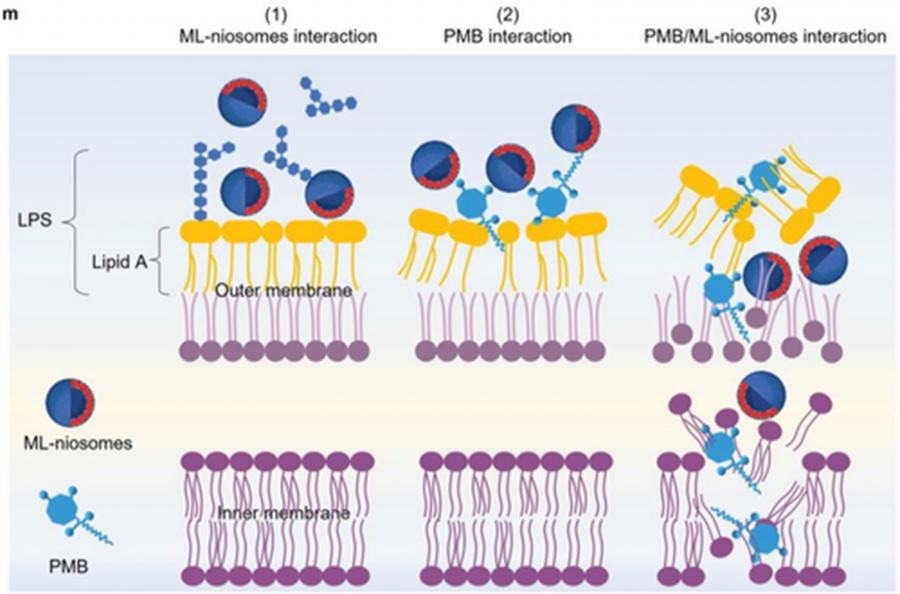An Australian research team, under the direction of Monash University, has developed a novel strategy for eliminating bacteria resistant to antibiotics by utilizing lipid nanoparticles that specifically target different bacterial cell surface layers.
 Schematic of the proposed mechanism of the ML-niosome treatment. 1) ML-niosomes bind to the surface polysaccharides removing some of the outer layers, 2) Polymyxin B can more freely reach the surface of the outer membrane. 3) Polymyxin and ML-niosomes then breakdown both the outer and inner membranes. Image Credit: Australia’s Nuclear Science and Technology Organisation
Schematic of the proposed mechanism of the ML-niosome treatment. 1) ML-niosomes bind to the surface polysaccharides removing some of the outer layers, 2) Polymyxin B can more freely reach the surface of the outer membrane. 3) Polymyxin and ML-niosomes then breakdown both the outer and inner membranes. Image Credit: Australia’s Nuclear Science and Technology Organisation
Gram-negative bacteria can be killed by combining antimicrobial lipids with nanocarrier lipids to produce nanoparticles, as evidenced by research published in Small.
The new strategy broadens the possibilities for the delivery of antibacterial lipids in conjunction with conventional therapies for bacterial diseases.
Prof Jian Li, Prof Anton Peleg, and A/Prof Hsin-Hui Shen of Monash University led the research team.
Dr. Anton Le Brun, an instrument scientist and co-author, contributed to the study by taking measurements on the neutron reflectometer Platypus and analyzing the data.
Neutron reflectometry is a useful tool for understanding the structure of cell membranes at the nanometer length scale.
Dr. Anton Le Brun, Study Co-Author and Instrument Scientist, Monash University
At the molecular level, the Platypus instrument at the Australian Centre for Neutron Scattering was employed to understand the mechanism at work in a combined ML-niosome/polymyxin B treatment.
Niosomes are drug-delivery vesicles that have unique features.
Polymyxin B is a last-resort antibiotic used to treat gram-negative bacterial infections. However, some bacteria are developing resistance to this antibiotic as well.
The scientists discovered that ML-niosomes attack the outer layer of the outer membrane, primarily composed of polysaccharides, by creating artificial membranes that replicate the features of the gram-negative bacterial cell surface.
The outer membrane is made visible by the ML-niosomes attaching to its surface. By breaking down the outer and inner membranes of the bacterial cell, polymyxin B can more easily assault and ultimately destroy it.
In addition to multidrug-resistant infections, the novel complex demonstrated efficacy against a broad range of hyper virulent strains of K. pneumoniae, A. baumannii, and P. aeruginosa.
Future research will examine the specific molecular mechanisms involved in this and the reasons behind the enhanced efficacy of the combination with polymyxin B.
Other steps will broaden the study to include screening against other infections where resistance to existing therapies is problematic.
CSIRO and the Doherty Institute were among the organizations that contributed.
Journal Reference:
Lai, X., et al. (2023) Polysaccharide-Targeting Lipid Nanoparticles to Kill Gram-Negative Bacteria. Small. doi:10.1002/smll.202305052